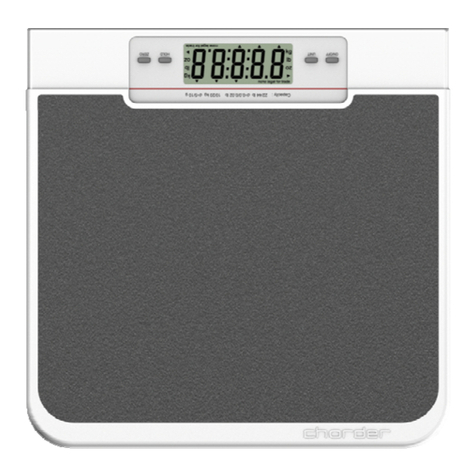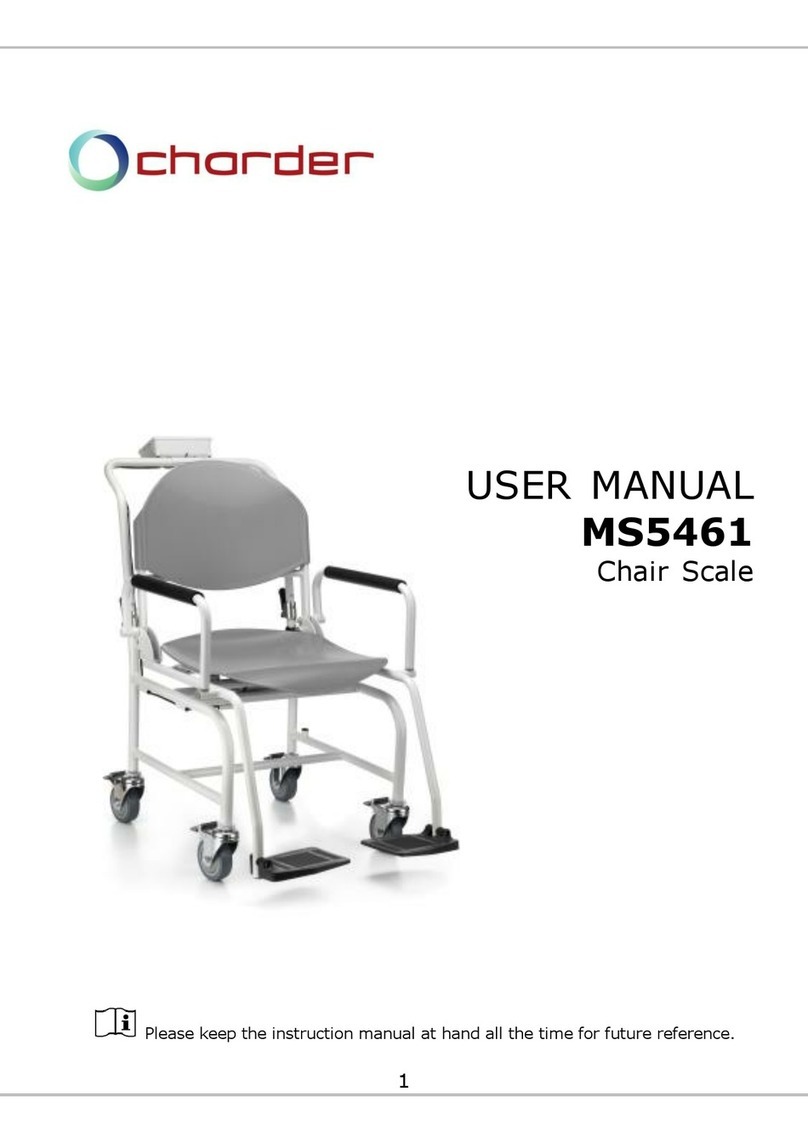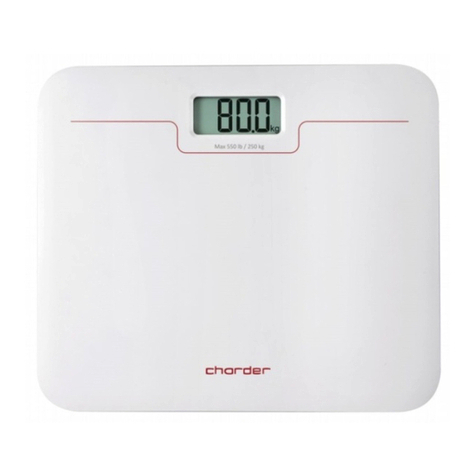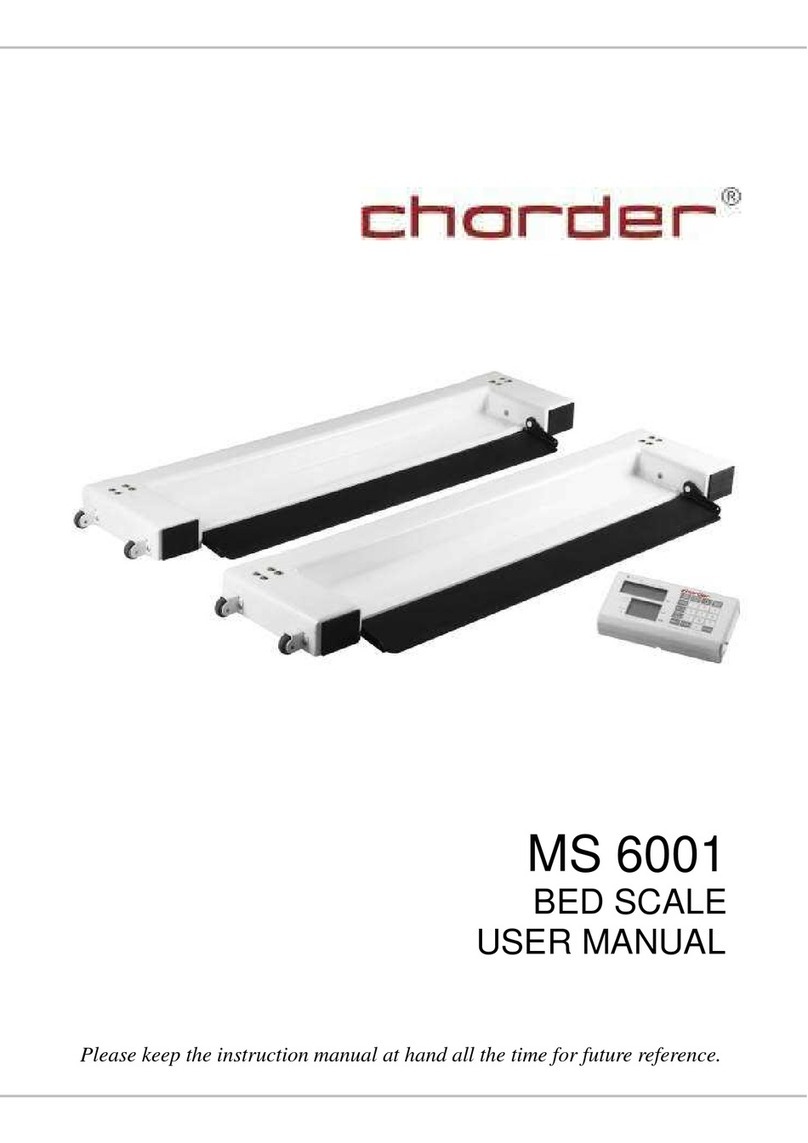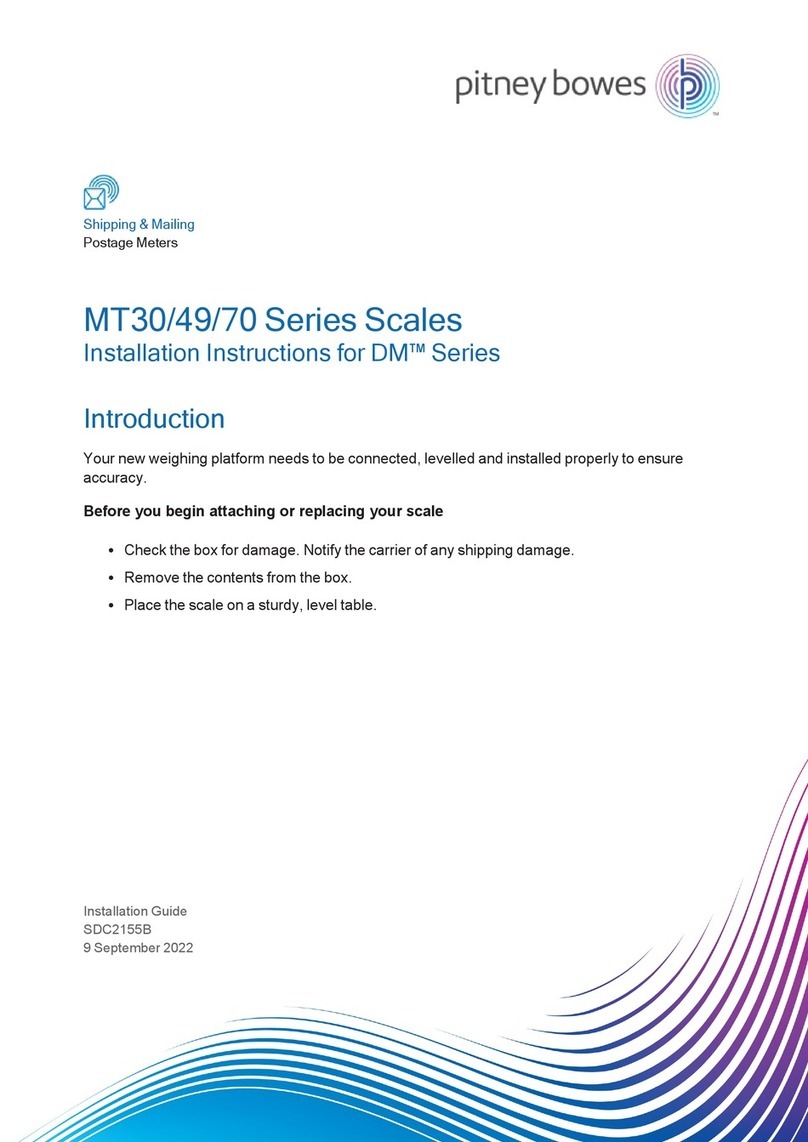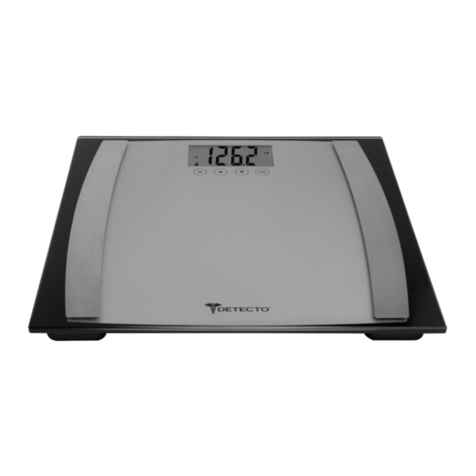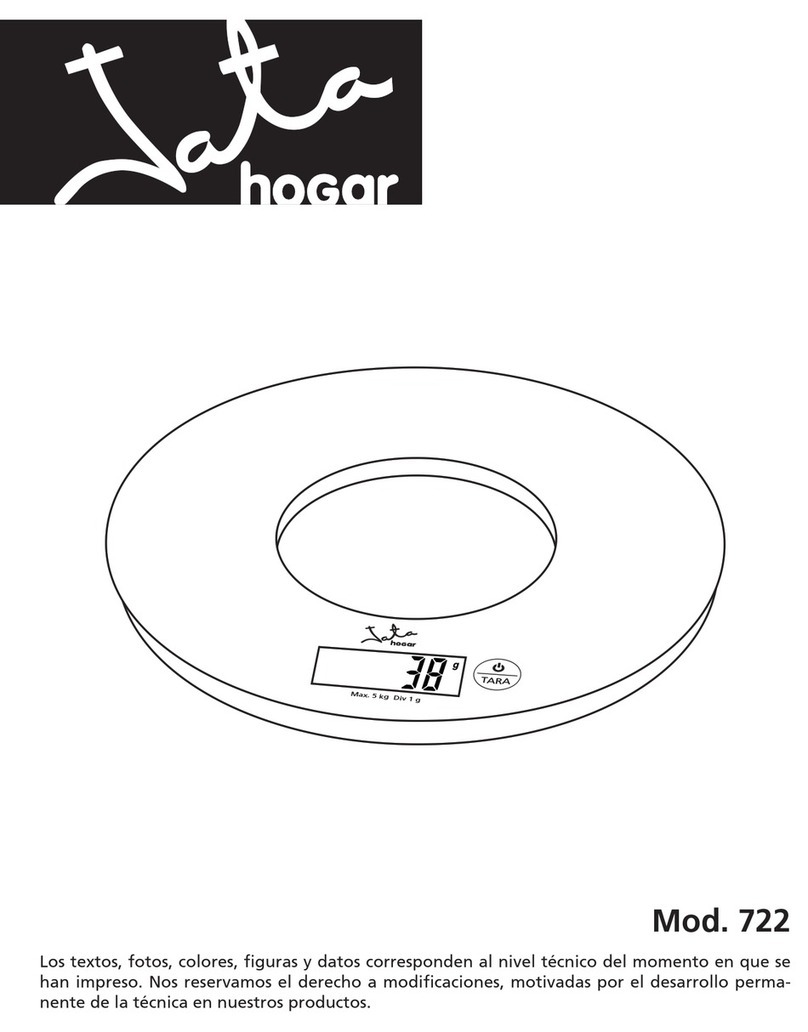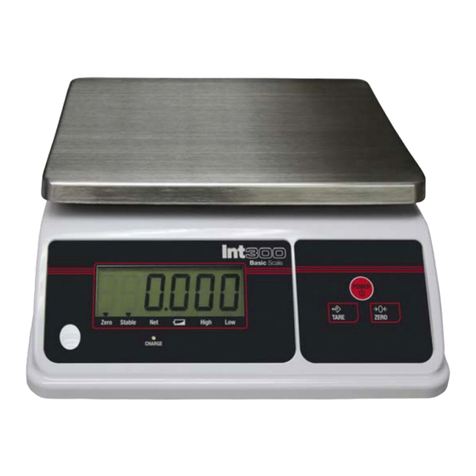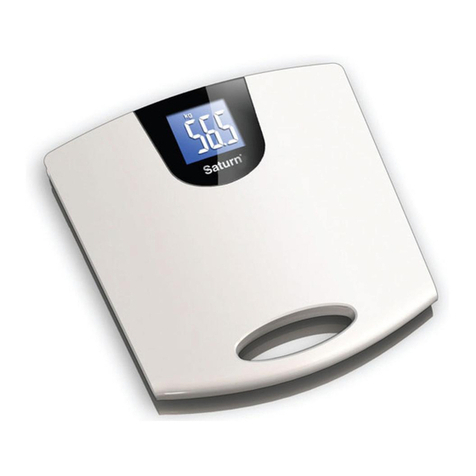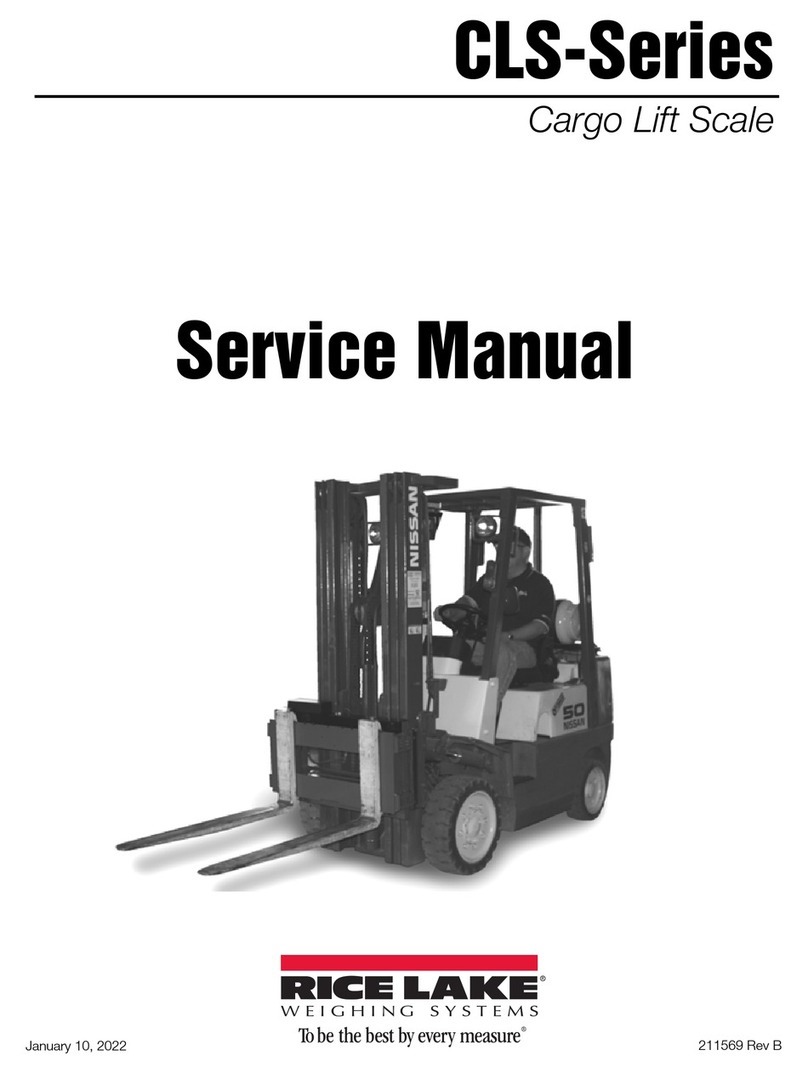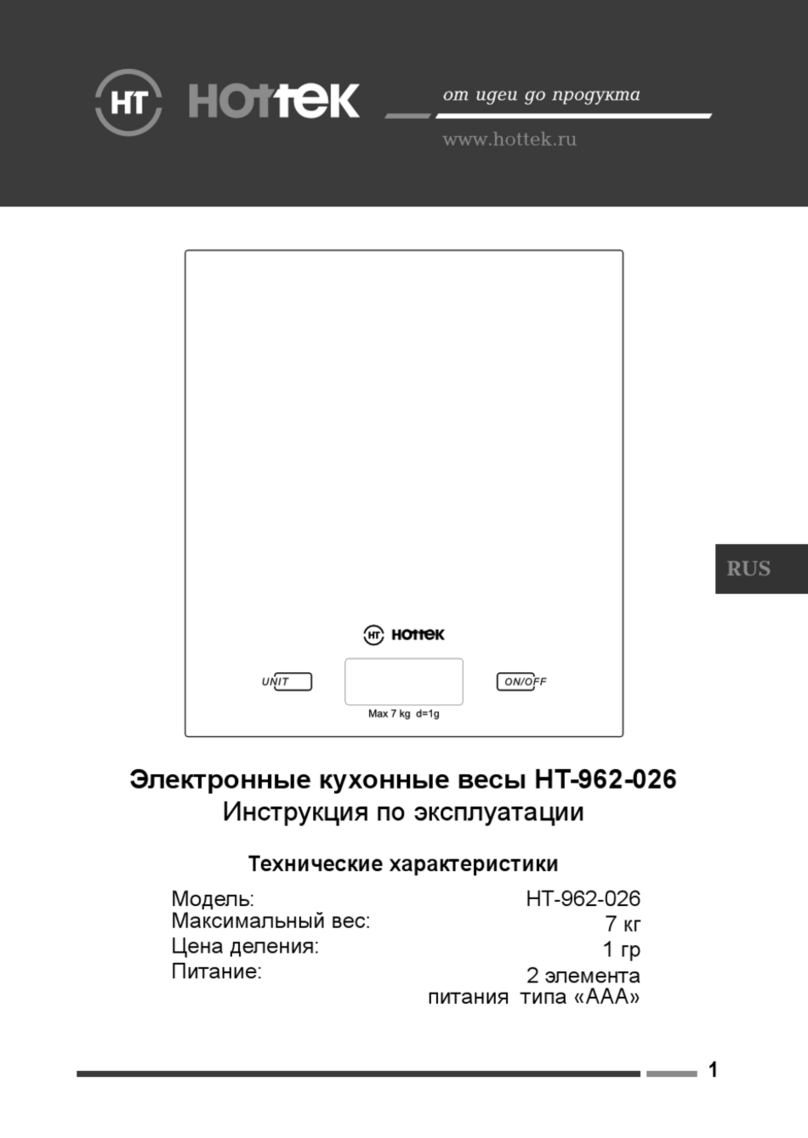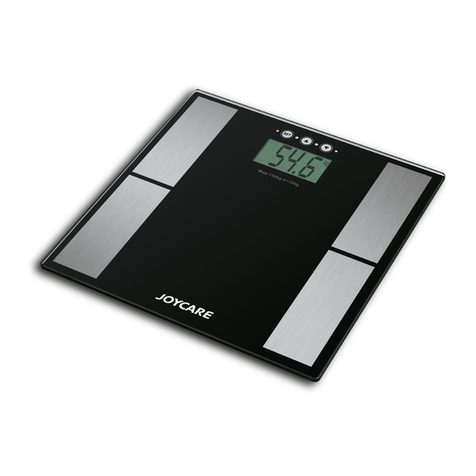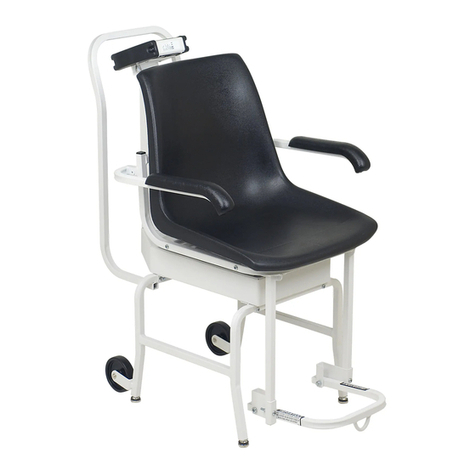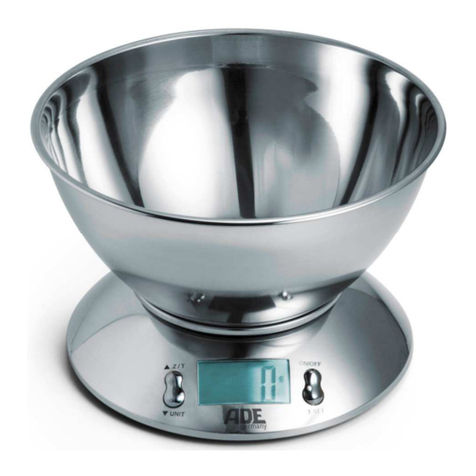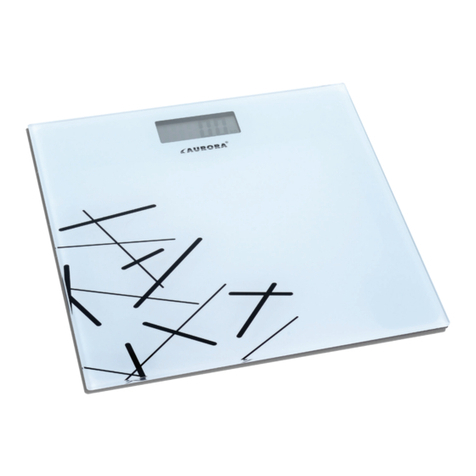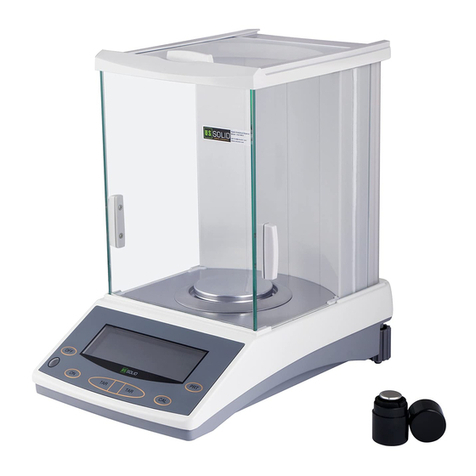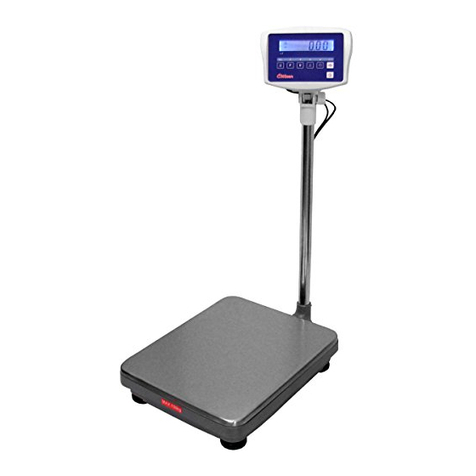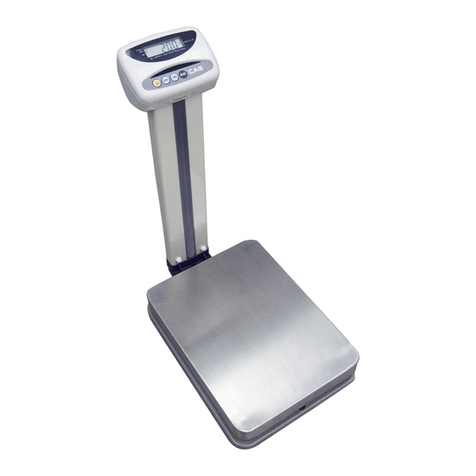Charder MS5410 User manual

1
USER MANUAL
MS5410
Chair Scale
Please keep the instruction manual at hand all the time for future reference.

2
Explanation of Graphic Symbols on Label/Packaging
Caution, consult
accompanying documents
before use
Separate collection for
waste of electrical and
electronic equipment,
in accordance with
Directive 2002/96/EC
Manufacturer of medical
device
Manufacturing year of
medical device
Carefully read user manual
before installation and
usage, and follow
instructions for use.
Medical electrical
equipment with Type B
applied part
Device catalogue number
Authorized
representative in the
European Community
Manufacturer's batch or lot
number
Device is a medical
device
Serial number
Unique Device Identifier
Device conforms to 93/42/EEC as amended
by 2007/47/EC Medical Device Directive. Four
digit number refers to Notified Body.
Device complies with International
Organization of Legal Metrology (Class III)
requirements (verified models only)
Device complies with EC directives (verified
models only)
M: Conformity label in compliance with
Directive 2014/31/EU for non-automatic
weighing instruments
18: Year in which conformity verification was
performed and the CE label was applied. (ex:
18=2018)
0122: Refers to Notified Body for metrology

3
Copyright Notice
Charder Electronic Co., Ltd.
No.103, Guozhong Rd., Dali Dist., Taichung City 41262 Taiwan
Tel: +886-4-2406 3766
Fax: +886-4-2406 5612
Website: www.chardermedical.com E-mail: info_cec@charder.com.tw
Copyright© Charder Electronic Co., Ltd. All rights reserved.
This user manual is protected by international copyright law. All content is
licensed, and usage is subject to written authorization from Charder
Electronic Co., Ltd. (hereinafter Charder) Charder is not liable for any
damage caused by a failure to adhere to requirements stated in this
manual. Charder reserves the right to correct misprints in the manual
without prior notice, and modify the exterior of the device for quality
purposes without customer consent.
Charder Electronic Co., Ltd.
No. 103, Guozhong Rd., Dali Dist.,
Taichung City, 41262 Taiwan

4
CONTENTS
I. Safety Notes .......................................................................... 5
A. General Information .............................................................5
B. EMC Guidance and Manufacturer's Declaration.........................8
II. Installation..........................................................................12
A. Adjusting footrests ............................................................. 12
B. Adjusting wheel height ....................................................... 14
C. Inserting Batteries ............................................................. 15
D. Using Adapter ................................................................... 18
III. Indicator............................................................................19
A. Indicator and Key Functions ................................................ 19
B. Display layout.................................................................... 20
IV. Using Device .......................................................................21
A. Basic Operation ................................................................. 21
B. Hold ................................................................................. 21
C. BMI.................................................................................. 21
D. Tare ................................................................................. 22
E. Pre-Tare ............................................................................ 22
F. Print ................................................................................. 26
V. Device Setup ........................................................................27
A. Setting Time & Date ........................................................... 27
B. Device Setup ..................................................................... 28
VI. Setup USB Connection to PC ...............................................30
VII. Wireless Connection..........................................................33
VIII. Troubleshooting...............................................................34
IX. Product Specifications ........................................................36
X. Declaration of Conformity ....................................................40

5
I. Safety Notes
A. General Information
Thank you for choosing this Charder Medical device. It is designed to be
easy and straightforward to operate, but if you encounter any problems
not addressed in this manual, please contact your local Charder service
partner.
Before beginning operation of the device, please read this user manual
carefully, and keep it in a safe place for reference. It contains important
instructions regarding installation, proper usage, and maintenance.
Intended Use
This device is intended to measure the weight of subjects with limited
mobility, for diagnosis of weight-related issues by professionals.
General Handling
Device should be placed on stable, flat, solid, non-slippery surface.
Usage on soft surfaces (ex: carpet) may result in inaccurate results.
Ensure all parts are properly locked and tightened before operating
the device.
Device is intended to measure one subject at a time.
Safety Instructions
Batteries should be kept away from children. If swallowed, promptly
seek medical assistance.
Expected service life: 5 years.
Always comply with appropriate regulations when using electrical
components under increased safety requirements.
Ensure voltage marked on power supply matches mains power
supply.
The device is intended for indoor use only.
Observe permissible ambient temperatures for use
Environmental
All batteries contain toxic compounds; batteries should be disposed
of via designated competent organizations. Batteries should not be
incinerated.
Cleaning
Device surface should be cleaned using alcohol-based wipes.
Corrosive cleansing liquids should not be used. Pressure-washers
should not be used.

6
Do not use large amounts of water when cleaning the device, as it
may cause damage to the internal electronics.
Always disconnect device from mains power before cleaning.
Maintenance
Device does not require routine maintenance. However, regular
checking of accuracy is recommended; frequency to be determined
by level of use and state of device. If results are inaccurate, please
contact local distributor.
Warranty/Liability
The period of warranty shall be eighteen (18) months, beginning on
the date of purchase. Please retain your receipt as proof of purchase.
No responsibility shall be accepted for damage caused through any
of the following reasons: unsuitable or improper storage or use,
incorrect installation or commissioning by the owner or third parties,
natural wear and tear, changes or modifications, incorrect or
negligent handling, chemical, electrochemical, or electrical
interference.
All maintenance, technical inspections, and repairs should be
conducted by an authorized Charder service partner, using original
Charder accessories and spare parts. Charder is not liable for any
damages arising from improper maintenance or usage.
Disposal
This product is not to be treated as regular household waste, but
should be taken to a designated collection points for electronics.
Further information should be provided by local waste disposal
authorities.
Warning
Only the original adapter should be used with the device. Using an
adapter other than the one provided by Charder may cause
malfunction.
Do not touch the power supply with wet hands.
Do not crimp the power cable, and avoid sharp edges.
Do not overload extension cables connected to the device.
Route cables carefully, to avoid tripping.
Keep device away from liquids.
Do not remove the plug by yanking on the cable.
Use only a correctly wired (100-240VAC) outlet, and do not use a
multiple outlet extension cable.

7
Do not under any circumstances dismantle or alter the device, as this
could result in electric shock or injury as well as adversely affect the
precision of measurements.
Do not place the device in direct sunlight, or in close proximity to an
intense heat source. Excessively high temperatures may damage the
internal electronics.
Warning
Measurements for physically disabled persons.
Physically disabled persons should not attempt to take
measurements alone, but instead should have their caretakers assist
them in using the device.
Footrest can only be used when subject is sitting in chair. To avoid
injury, subject should refrain from standing on footrest, as device
may tip over if used incorrectly.
Incident Reporting
Any serious incident that has occurred in relation to the device should be
reported to the manufacturer, EU representative (if device is used in EU
member state), and competent authority of user/subject's member state.

8
B. EMC Guidance and Manufacturer's Declaration
Guidance and manufacturer’s declaration-electromagnetic emissions
The MS5410 Chair Scale is intended for use in the electromagnetic environment specified
below. The customer or the user of the device should assure that it is used in such an
environment.
Emission test
Compliance
Electromagnetic
environment-guidance
RF emissions CISPR 11
Group 1
The device uses RF energy only for
its internal function. Therefore, its
RF emissions are very low and are
not likely to cause any interference
in nearby electronic equipment.
RF emissions CISPR 11
Class B
The device is suitable for use in all
establishments, including domestic
establishments and those directly
connected to the public low-voltage
power supply network that supplies
buildings used for domestic
purposes.
Harmonic emissions IEC
61000-3-2
Class A
Voltage fluctuations /flicker
emissions IEC 61000-3-3
Compliance

9
Guidance and manufacturer’s declaration-electromagnetic immunity
The MS5410 Chair Scale is intended for use in the electromagnetic environment specified
below. The customer or the user of the device should assure that it is used in such an
environment.
Immunity test
IEC 60601
test level
Compliance
level
Electromagnetic
environment-guidance
Electrostatic
discharge(ESD)
IEC 61000-4-2
±8 kV contact
±2 kV, ± 4 kV,
± 8 kV, ± 15 kV
air
±8 kV contact
±2 kV, ± 4 kV,
± 8 kV, ± 15 kV
air
Floors should be wood, concrete
or ceramic tile. If floors are
covered with synthetic material,
the relative humidity should be
at least 30%
Electrical fast
transient/burst
IEC 61000-4-4
± 2kV for
power supply
lines
+ 1kV for
input/output
lines
+ 2kV for power
supply lines
+ 1kV for
input/output
lines
Mains power quality should be
that of a typical commercial or
hospital environment.
Surge IEC
61000-4-5
± 1kV line(s) to
line(s)
± 2kV line(s) to
earth
+ 1kV line(s) to
line(s)
+ 2kV line(s) to
earth
Mains power quality should be
that of a typical commercial or
hospital environment.
Voltage Dips,
short interruptions
and voltage
variations on
power supply
input lines IEC
61000-4-11
0% UT for 0,5
cycle
0% UT for 1
cycle
70% UT(30%
dip in UT) for
25 cycles
0% UT for 5 s
0% UT for 0,5
cycle
0% UT for 1
cycle
70% UT(30%
dip in UT) for 25
cycles
0% UT for 5 s
Mains power quality should be
that of a typical commercial or
hospital environment. If the
user of the device requires
continued operation during
power mains interruptions, it is
recommended that the device
be powered from an
uninterruptible power supply or
a battery.
Power
frequency(50/60
Hz) magnetic field
IEC 61000-4-8
30 A/m
30 A/m
The device power frequency
magnetic fields should be at
levels characteristic of a typical
location in a typical commercial
or hospital environment.
NOTE UT is the a.c. mains voltage prior to application of the test level.

10
Guidance and manufacturer’s declaration-electromagnetic immunity
The MS5410 Chair Scale is intended for use in the electromagnetic environment specified
below. The customer or the user of the device should assure that is used in such an
environment.
Immunity test
IEC 60601 test
level
Compliance
level
Electromagnetic
environment-guidance
Conducted RF
IEC 61000-4-6
Radiated RF IEC
61000-4-3
3 Vrms
150 KHz to 80 MHz
6 V in ISM bands
between 0,15 MHz
and 80 MHz
80 % AM at 1 kHz
3 V/m
80MHz to 2,7 GHz
3 Vrms
150 KHz to 80
MHz
6 V in ISM
bands between
0,15 MHz and
80 MHz
80 % AM at 1
kHz
3 V/m
80MHz to 2,7
GHz
Portable and mobile RF
communications equipment
should be used no closer to any
part of the device including
cables, than the recommended
separation distance calculated
from the equation applicable to
the frequency of the
transmitter.
Recommended separation
distance:
d = 1,2 √P
d = 1,2 √P 80MHz to 800 MHz
d = 2,3 √P 800MHz to 2,5 GHz
Where P is the maximum output
power rating of the transmitter
in watts (W) according to the
transmitter manufacturer and d
is the recommended separation
distance in metres (m).
Field strengths from fixed RF
transmitters, as determined by
an electromagnetic site surveya,
should be less than the
compliance level in each
frequency rangeb.
Interference may occur in the
vicinity of equipment marked
with the following symbol:

11
NOTE1 At 80 MHz and 800 MHz, the higher frequency range applies.
NOTE2 These guidelines may not apply in all situations. Electromagnetic propagation is
affected by absorption and reflection from structures, objects and people.
a Field strengths from fixed transmitters, such as base stations for radio (cellular/cordless)
telephones and land mobile radios, amateur radio, AM and FM radio broadcast and TV
broadcast cannot be predicted theoretically with accuracy. To assess the electromagnetic
environment due to fixed RF transmitters, an electromagnetic site survey should be
considered. If the measured field strength in the location in which the device is used
exceeds the applicable RF compliance level above, the device should be observed to
verify normal operation. If abnormal performance is observed, additional measures may
be necessary, such as re-orienting or relocating the device.
b Over the frequency range 150 kHz to 80 MHz, field strengths should be less than 3 V/m.
Recommended separation distance between portable and mobile RF
communications equipment and the MS5410 Chair Scale
The device is intended for use in an electromagnetic environment in which radiated RF
disturbances are controlled. The customer or the user of the device can help prevent
electromagnetic interference by maintaining a minimum distance between portable and
mobile RF communications equipment (transmitters) and the device as recommended
below, according to the maximum output power of the communications equipment.
Rated maximum
output power of
transmitter
W
Separation distance according to frequency of
transmitter m
150 kHz to 80
MHz
d =1,2√P
80 MHz to 800
MHz
d =1,2√P
800 MHz to 2,5
GHz
d =2,3√P
0,01
0,12
0,12
0,23
0,1
0,38
0,38
0,73
1
1,2
1,2
2,3
10
3,8
3,8
7,3
100
12
12
23
For transmitters rated at a maximum output power not listed above, the recommended
separation distance d in metres (m) can be estimated using the equation applicable to the
frequency of the transmitter, where p is the maximum output power rating of the
transmitter in watts (W) according to the transmitter manufacturer.
NOTE1 At 80 MHz and 800 MHz, the separation distance for the higher frequency range
applies.
NOTE2 These guidelines may not apply in all situations. Electromagnetic propagation is
affected by absorption and reflection from structures, objects and people.

12
II. Installation
A. Adjusting footrests
1. Remove bolt to adjust length of footrest
2. Adjust footrest height according patient leg length

13
3. After completing adjustment, insert bolts to secure footrest

14
B. Adjusting wheel height
1. Place device on flat surface, apply wheel brakes
2. To tighten wheel castor, loosen counternut slightly. After loosening,
turn wheel frame clockwise to tighten.
3. Adjust wheel height until air bubble on level indicator is level
NOTE: Be careful not to lose wheels during adjustment
Counternut
Wheel frame
Brakes

15
C. Inserting Batteries
1. Open battery housing cover
2. Accessing batteries
3. Use either rechargeable battery pack, or AA batteries
Take out the battery
housing

16
4. Ensure batteries are installed into the housing correctly
5. Install the battery housing into the compartment, and make sure the
right side of housing pin is facing towards inside of the connecting
position
Rechargeable
Battery Housing
AA-size Battery Housing

17
6. Slide back the cover to close the battery housing compartment. Turn
on power to confirm that battery is correctly installed.
Using Rechargeable Battery (optional)
The rechargeable battery should be recharged at least once every 3
months, regardless of if the device has been used. Battery can be
charged by plugging device's exclusive adapter into AC Connector Port.
After a long period in storage (e.g. >3 months), the battery should run a
full cycle (charge/discharge) to allow it to restore full capacity.
Ensure rechargeable battery housing is installed and inserted properly
into the compartment.
If prompt displays on the LCD, please charge battery
promptly to avoid battery damage.
AC Connector Port

18
D. Using Adapter
1. Connect adapter to indicator before connecting to mains power supply
2. Disconnect adapter from mains power supply before unplugging
adapter pin from indicator.
AC Connector Port

19
III. Indicator
A. Indicator and Key Functions
(Wireless functionality optional)
Key Function
1. ON/OFF: Power on or power off.
2. ZERO: Reset display to 0.0 kg display. Press and hold for 3
seconds to enter device settings.
3. M1-5: Saving pre-tare values (up to 5)
4. PRE-TARE: Pre-tare the known weight of an object (ex: chair)
before beginning measurement.
5. TARE: Allows user to deduct weight from reading after
measurement
6. PRINT: When printer or PC is connected to the scale, press this
key to print results
7. BMI: Calculation of Body Mass Index
8. HOLD: Determine stable weighing value - used when weight is
unstable. Press and hold for 3 seconds to enter time setting.
9. - 0-9: For entering digits.

20
10. CLEAR: Clear incorrect data input.
11. ENTER: Confirm input
B. Display layout
Definitions
Stable symbol: Indicate that weight is stable.
Zero symbol: Weight is at zero
Negative weight: Weight under zero.
Low battery: Battery needs to be charged or replaced.
Table of contents
Other Charder Scale manuals
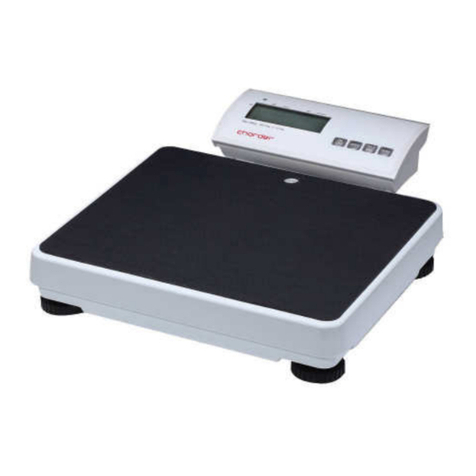
Charder
Charder MS5711 User manual
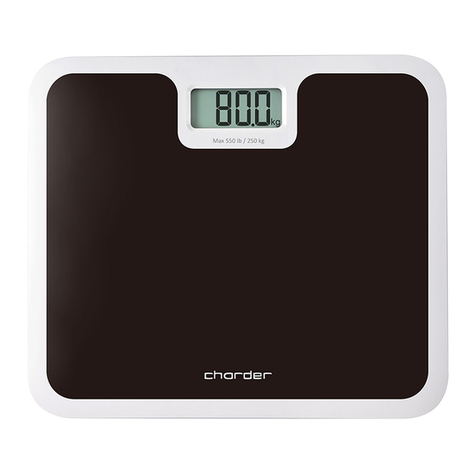
Charder
Charder MS7301 User manual
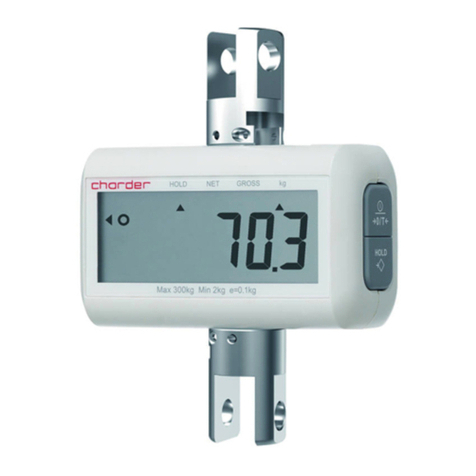
Charder
Charder MHS2510/2610 User manual
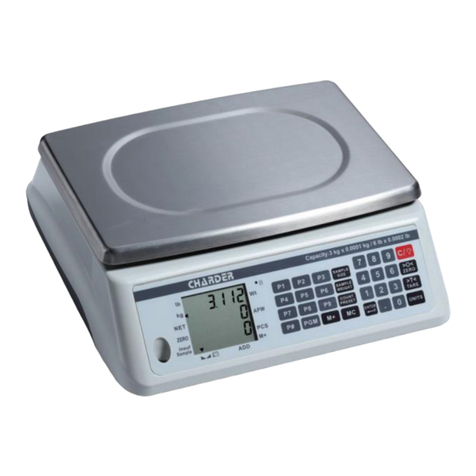
Charder
Charder P520 User manual

Charder
Charder R460 User manual
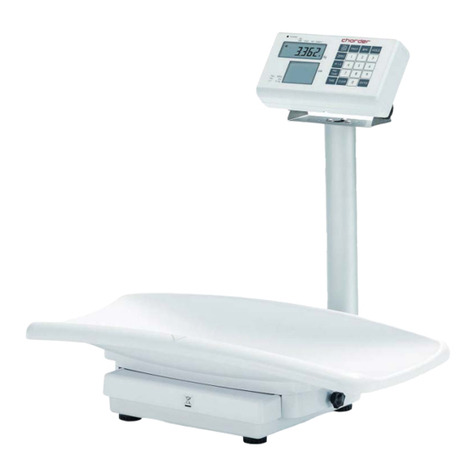
Charder
Charder MS21NEOV User manual
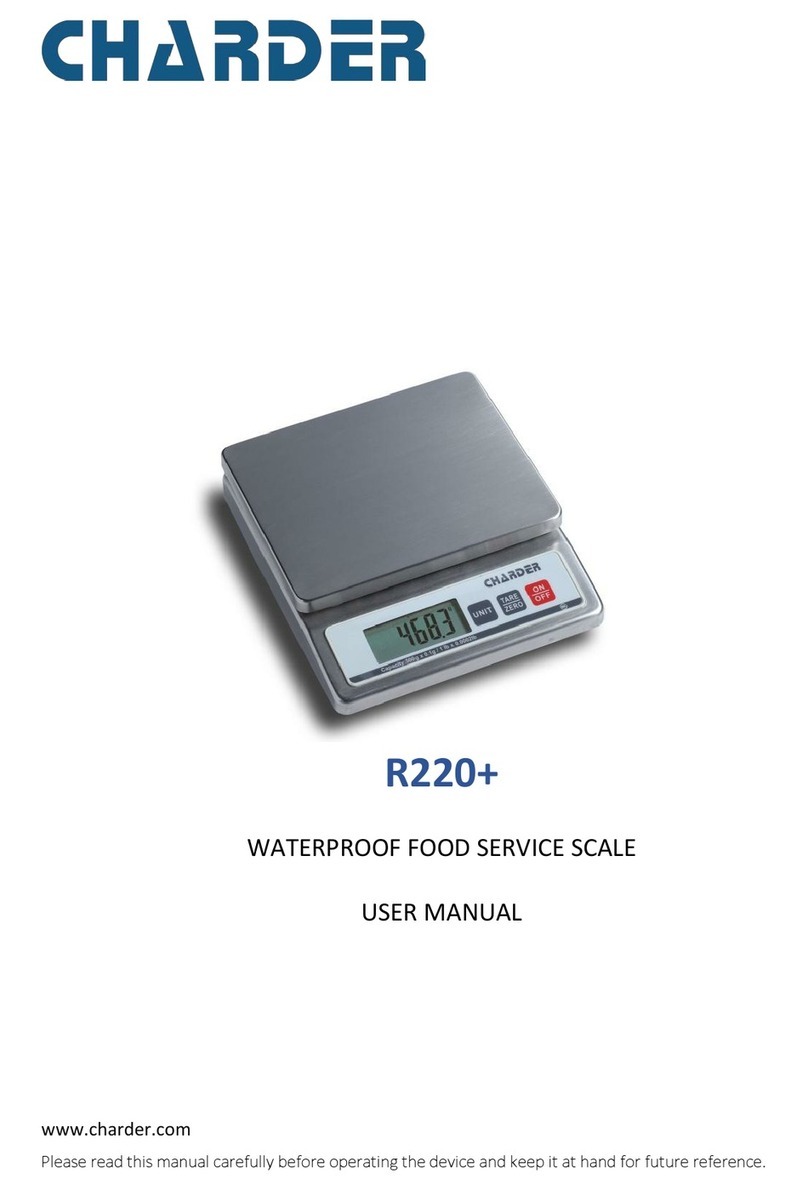
Charder
Charder R220+ User manual
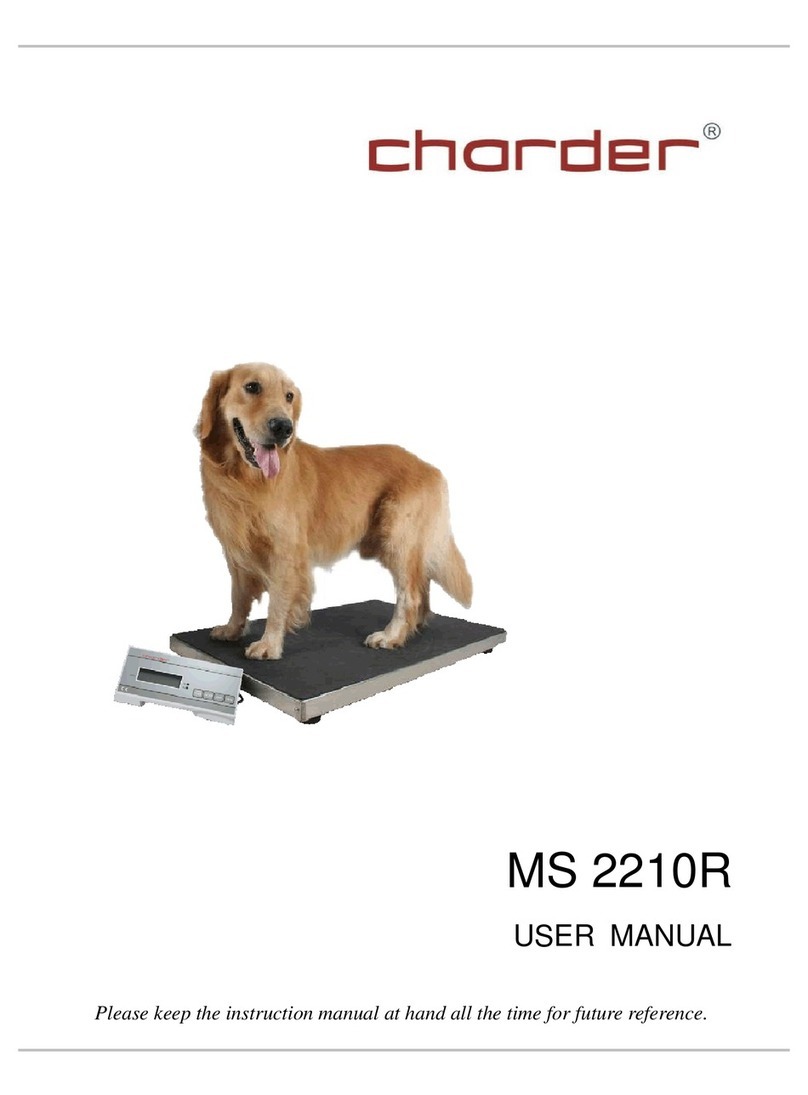
Charder
Charder MS 2210R User manual
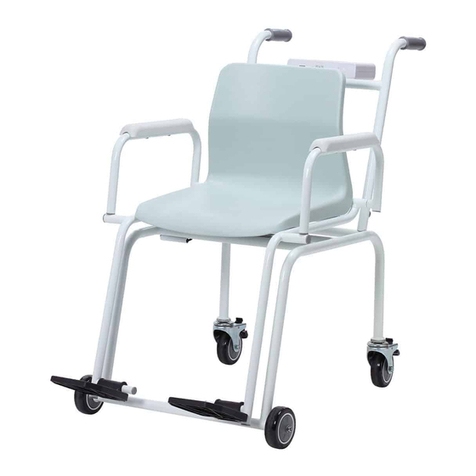
Charder
Charder MS5810 User manual
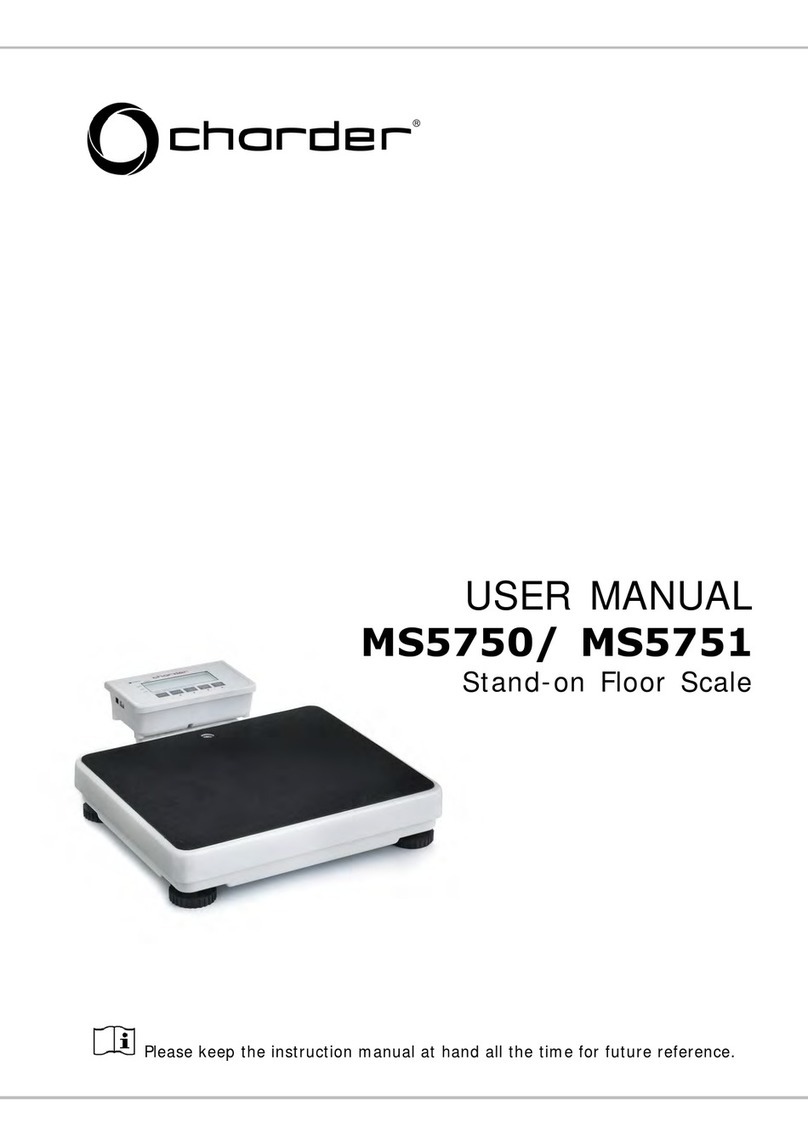
Charder
Charder MS5750 User manual
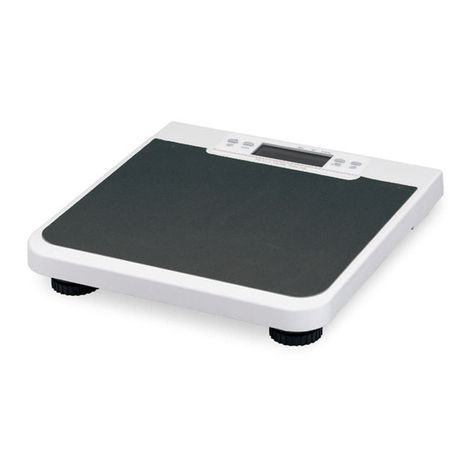
Charder
Charder MS6110 User manual
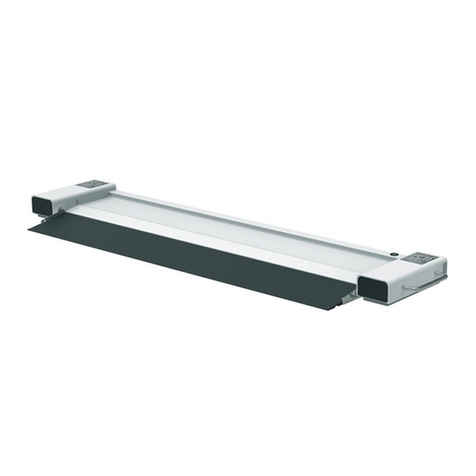
Charder
Charder MS6001 User manual
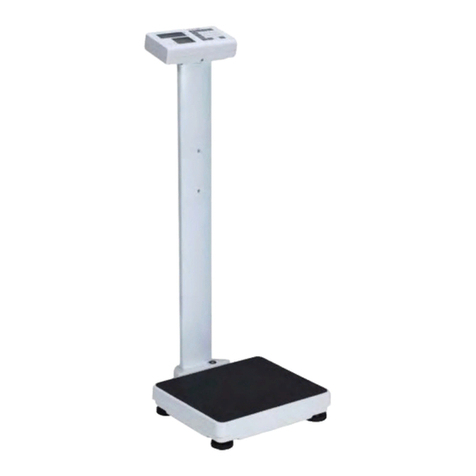
Charder
Charder MS4910 User manual
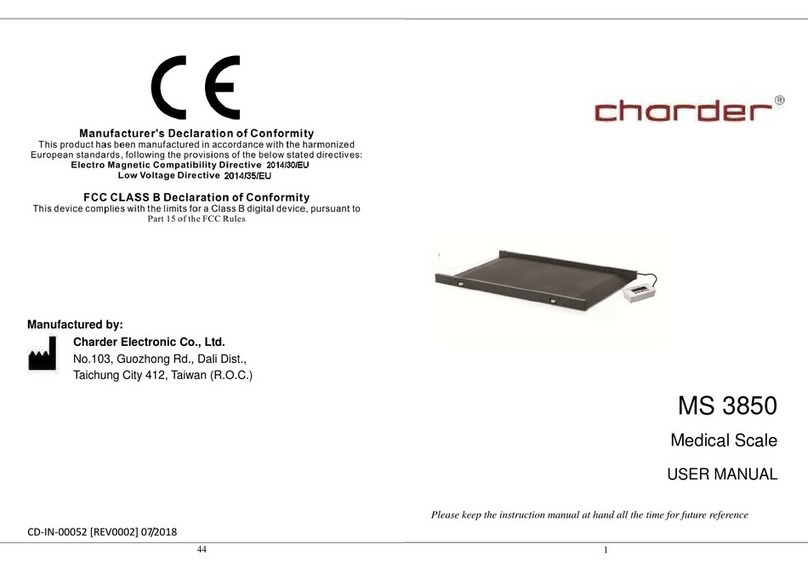
Charder
Charder MS 3850 User manual
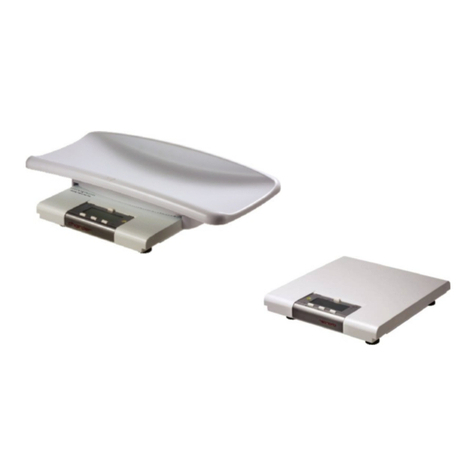
Charder
Charder MS 4211 User manual
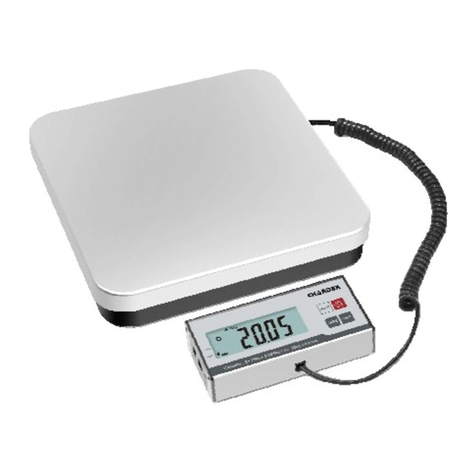
Charder
Charder R260 User manual
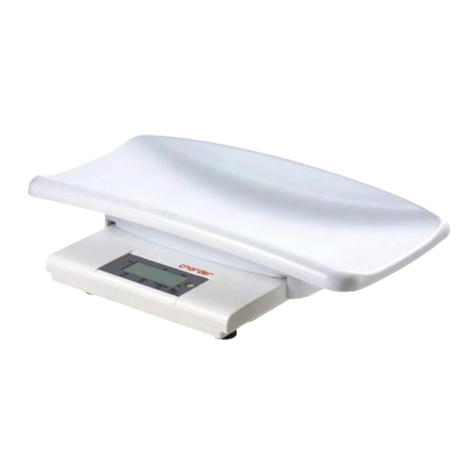
Charder
Charder MS4200 User manual
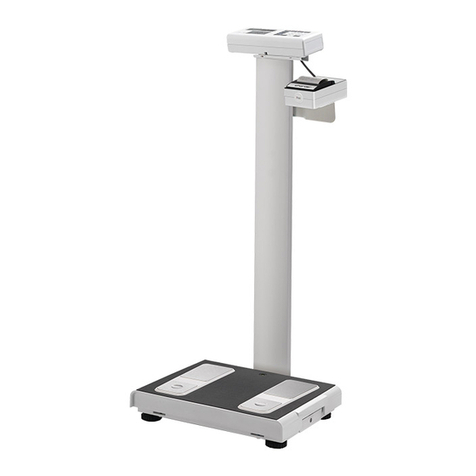
Charder
Charder DP3700 User manual
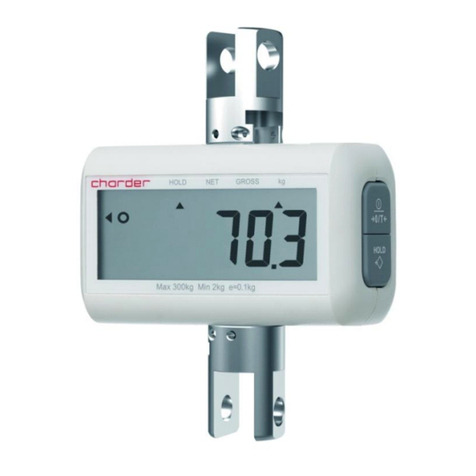
Charder
Charder MHS2710 User manual
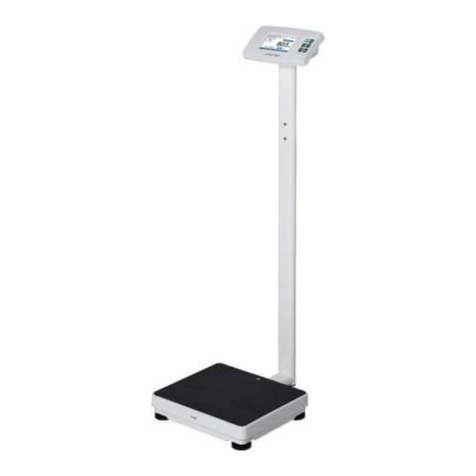
Charder
Charder MS4980 User manual
